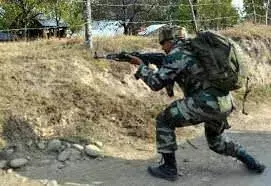The Changing Canvas Of Army’s RR Units
The challenge of maintaining a close knit fighting unit has enhanced

No sooner did the nation get over the tragedy of heroic martyrdom of Commanding Officer 19 Rashtriya Rifles (RR) alongwith one of his company commanders, and a Jammu and Kashmir Police officer than we got the shocking news of a terrible incident of fratricide in 48 RR.
In the latest unfortunate incident, as per the media report, an officer opened fire at his colleagues and subordinates at a camp in Thanamandi in J&K’s Rajouri district. At least three to five personnel including two officers were injured. The Army as per the official report is investigating the matter that it has termed as ‘in house’.
Rather than delving into particularities of the aforesaid actions, since it would be not in order, this piece endeavours to dig deeper into the general milieu of a RR unit comprising the in-expendable human resources that it possesses. Vis-a-vis the low intensity conflict that the Indian Army has been fighting in Jammu and Kashmir, RR units have always remained in the forefront. These outstanding units have been in the news mostly because of the valour and sacrifice of its troops, led by their leaders.
In service of the nation and in line with the ethos of the Indian Army, several RR Commanding Officers have laid down lives, while leading their men from front and by example. To name a few: Colonels Rajinder Chauhan and Ashutosh Sharma from 21 RR, Col. Jojan Thomas from 45 RR, Col. Santosh Mahadik from 41 RR, Col. M.N. Rai from 42 RR, Col. Manpreet Singh 19 RR.
In tandem, several Officers, Junior Commissioned Officers and Jawans have laid down their lives in the line of duty. We shall always be proud of the sacrifices made by these 'men of courage’ and no words would be enough to express the nation’s gratitude to them and their families.
Notwithstanding the above, unfortunate mishaps of fratricide and suicide do surface in these units that are deployed in combat, facing an adversary who is invisible and undefined. It would be rather unfair to have one sided perspective of such unfortunate incidents and the nuances of the environment that a RR unit operates in, need to be comprehended.
The RR was raised in the early 90s, primarily to be deployed in a counter-insurgency role in the hinterland of Jammu & Kashmir. The intent behind raising this specialist outfit was to relieve Indian Army’s infantry units from protracted deployments in sub conventional roles, which correctly was seen as coming, at the cost of efficiency in conventional roles on the borders. Since then, RR has been through thick and thin of the nation’s journey stabilising J&K; a role performed with elan by RR.
The challenging role in the given terrain warranted a tailor made self sufficient unit wherein the Commanding Officer need not look back for support. Resultantly, the RR units as conceived and raised, comprise troops on deputation of two to three years from various units of the Indian Army, which are primarily from the combat arms like Infantry, Artillery, Armoured, Army Air Defence, Engineers as also from service units to complete the picture. The vision and foresight behind the raising of RR has borne excellent results and the present stability in J&K is a testimony to the same.
As mentioned, a RR unit is heterogeneous in composition, with officers and jawans serving in the unit for a limited duration. This is unlike an infantry or an artillery or an armoured unit where the personnel serve together for their entire service and thrive under the umbrella of regimentation. It is noted that for efficiency in combat, pervasiveness of highest degree of bonding amongst the combatants, is an imperative.
Units of the Indian Army are famous to have fought valiantly in the name of ‘reputation and flag of the country and the regiment’. The sense of bonding off-combat, is the only route to bonding during battle; talking of men against fire, where lives matter.
This makes the task at hand for the leadership in RR, very challenging as they have to facilitate and sustain the ultimate sense of camaraderie amongst men they command. The challenge becomes onerous for the fact that the beginning of building up this regimentation has to be made from scratch. All this is a function of the genius of leadership.
In the decades of 90s and till about 2007, i.e. before the situation in J&K stabilised, the bonding amongst men used to come about naturally due to frequent combat operations and vibrancy in professionalism resulting from fast paced actions. In present times, in the context of lower terrorism indices, the challenge of maintaining a close knit fighting unit has enhanced.
The relatively stabler situation doesn’t churn out too many contacts with the terrorists. The bullets no longer fly around, that frequently in the past left the men with no option but to bond and be interdependent.
The challenges of present leadership have further multiplied, in the context of the old time parameters of success that the system continues to value and uphold. In addition, the unfulfilled societal and family commitments of a soldier deployed in an active operational area, make the mix deadlier.
These aspects have aggravated the pressures at leadership levels, which may have witnessed in manifestation of rushing for results, of course with good intention, or the cascading adverse effects unfolding in psychological and emotional meltdown.
Colonel Shashank Ranjan is a retired Infantry Officer who has served in several appointments in Rashtriya Rifles formations, and commanded a battalion. He now teaches at the O.P. Jindal Global University. Views expressed are the writer’s own.


